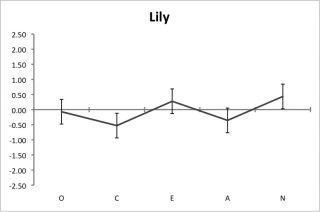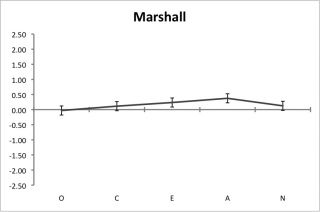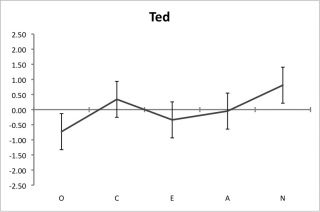Big 5 Personality Traits
How I Met Your Mother, Personalitywise
Who is the most awesome?
Posted February 4, 2013

Written with Leonard Chen.
In my body, where the shame gland should be, there is a second awesome gland. True story.
~ Barney Stinson (source)
After having shown that TV characters are not unidimensional (see an assessment of “Friends”), we turn our Big Five guns on How I Met Your Mother. The senior blogger (JK) can’t say that he is intimately familiar with Barney, Marshall, Lily, Robin, and Ted. In fact, he finds the whole bar booth routine tedious. The junior blogger (LC) takes a more sanguine view. The senior blogger’s younger daughter (13) is a big fan. We all agree that Barney is awesome. To get a fix on the characters before collecting data, we consulted Wikipedia and found an enlightening introduction to the cast.
Personality psychologists known as Big Fivers believe – wait for it – that the Big Five personality traits are the route d’or to knowing people. For those who have missed the memo, here’s an update: The Big Five (naturally capitalized) are personality traits so broad that they are believed to cover the spectrum of individual differences. Once you have a person’s profile of scores over the Big Five, you know the person, at least in broad strokes. After they emerged from factor-analytic work at an Air Force base (Tupes & Christal, 1961), the Big Five have gained widespread acceptance (Goldberg, 1992). Though periodically challenged and reviled, they have persisted. Here they are: [O] Openness to new experience, [C] Conscientiousness, [E] Extraversion, [A] Agreeableness, and [N] Neuroticism. Strung together, the letters spell OCEAN. As we did when taking the pulse of “Friends,” we used trait pairs recommended by Gosling et al. (2003). Namely, “open to new experiences and complex,” “dependable and self-disciplined,” “extraverted and enthusiastic,” “critical and quarrelsome” [reverse keyed], and “anxious and easily upset.”

We showed the episode Subway Wars (Season 6, Episode 4, aired on October 11, 2010) to a class of 26 undergraduate students. Each student rated each of the 5 HIMYM characters, the Dalai Lama, and the self. We then standardized the ratings to set the grand mean for each trait to 0 and the standard deviation to 1. The first set of figures shows the mean and standard error for each character and each of the OCEAN traits. The pop-out result is that Barney is indeed awesome. It is not that he received the most favorable ratings overall. Instead, Barney is the only character with character. His profile is

highly variable over traits, which makes him distinctive. Barney can be summarized as being highly extroverted, not conscientious (he has a Machiavellian streak) and not neurotic (he is not prone to shame – see the anatomical epigraph), although Wikipedia relates that he has “abandonment issues”). We also note that raters show less consensus when it comes to Barney. Their ratings are more variable within each trait than they are for other characters. In contrast, Lily and Marshall are cursed with ordinariness. Their profiles are like old tires. They have no tread. Marshall is a virtual everyman. Adolphe Quetelet

(1835/1968), who regarded averages as Platonic ideals, would have loved him. The rest of us are bored. Robin and Ted show a bit more variability, but their profiles are very similar. One wonders if they were made for each other [viewers of the show know that they were not, appearances notwithstanding]. They share a neurotic streak that sets them apart from the others. An alternative representation of the data is to give each trait its own panel with a profile of average standardized ratings over the characters (not done here). Again, Barney would emerge awesome in his distinctiveness.

There is another definition of awesome, and that is social desirability. By this definition, an awesome person scores high on all traits except neuroticism. In our set of characters, that is HHDL (His Holiness the Dalai Lama). What up! With him, even scoring average on extroversion is a hit, given the role he represents (oops, that’s creeping contextualism!). Most people also regard themselves as awesome (e.g., Brown, 2012). Here we see that the profile of average self-ratings resemblance to Dalai’s profile.
We took a closer look at the resemblance issue by

correlating self-ratings with ratings for another character one character at a time. After years of studying social projection, JK figured that these correlations would be highest for the Lama, Dalai. Why? Because the Lama is viewed in generally desirable terms but there is little concrete information about his character. Hence, he is the perfect screen on which people can project their own positive self-images. Indeed, we found the mean correlation between self-ratings and Lama ratings to be higher (.57) than mean correlations involving ratings of Barney (.08), Lily (-.38), Marshall (.018), Robin (.05), or

Ted (.13).
Our modest attempt at capturing the Mother characters’ characters is not the only effort in this area. A certain “Bridgette” has apparently figured them out and has developed a test for you to see which character is most similar to you. JK took the test and found he is most like Lily. Hm. Treadless according Los Cinco Grandes. LC got stuck with Marshall. Equally treadless. Perhaps that’s why we work well together.

Brown, J. D. (2012). Understanding the Better Than Average Effect: Motives (still) matter. Personality and Social Psychology Bulletin, 38, 209-209.
Goldberg, L. R. (1992). The development of markers for the Big-Five factor structure. Psychological Assessment, 4, 1992, 26-42.
Gosling, S. D., Rentfrow, P. J., & Swann, W. B., Jr. (2003). A very brief measure of the Big Five personality domains. Journal of Research in Personality, 37, 504-528.
Quetelet, A. (1835/1968). A treatise on man and the development of his faculties. New York, NY: B. Franklin.
Tupes, E. C., & Christal, R. E. (1961). Recurrent personality factors based on trait ratings. Technical Report ASD-TR-61-97. Lackland Air Force Base, TX: U.S. Air Force.




